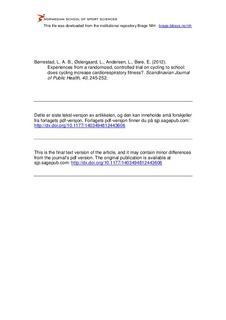| dc.contributor.author | Børrestad, Line Anita Bjørkelund | |
| dc.contributor.author | Østergaard, Lars | |
| dc.contributor.author | Andersen, Lars Bo | |
| dc.contributor.author | Bere, Elling | |
| dc.date.accessioned | 2013-05-03T12:55:22Z | |
| dc.date.available | 2013-05-03T12:55:22Z | |
| dc.date.issued | 2012-05 | |
| dc.identifier | Seksjon for idrettsmedisinske fag / Department of Sports Medicine | |
| dc.identifier.citation | Scandinavian journal of public health. 2012, 40(3), 245-252 | no_NO |
| dc.identifier.uri | http://hdl.handle.net/11250/171180 | |
| dc.description | I Brage finner du siste tekst-versjon av artikkelen, og den kan inneholde ubetydelige forskjeller fra forlagets pdf-versjon. Forlagets pdf-versjon finner du på sjp.sagepub.com: http://dx.doi.org/10.1177/1403494812443606 / In Brage you'll find the final text version of the article, and it may contain insignificant differences from the journal's pdf version. The original publication is available at sjp.sagepub.com: http://dx.doi.org/10.1177/1403494812443606 | no_NO |
| dc.description.abstract | Aims: The objective of the present study was to investigate the effect of a 12-week randomised controlled cycling-to-school trial on cardiorespiratory fitness. Methods: A total of 53 10- to 13-year-old children from one public school were included. The children were randomised into either a cycling group or a control group. The cycling group was encouraged to cycle to and from school each day during a period of 12 weeks. Peak oxygen consumption (VO2peak) and anthropometrical data (weight and height) were measured at baseline and at the end of the 12-week period. Results: No significant differences were observed in VO2peak change over the 12-week period between the cycling group and the control group (49.7 ml O2/min/kg vs. 50.6 ml O2 /min/kg; effect size=−0.13, F=0.495, p=0.486). Within the intervention group, 69.2% (95% CI 50.1–88.2) started cycling, and within the control group 40.8% (95% CI 20.9–60.5) started cycling. Given that several children in both groups (intervention and control) started cycling to school, re-analyses were conducted between those starting cycling and those not starting cycling. At follow up, a significant difference between those starting cycling and those who did not starting cycling was observed in VO2peak (51.7 ml O2/min/kg vs. 47.9 ml O2/min/kg; effect size=0.49, F=8.145, p=0.007), after adjustment for baseline scores, gender and age. Conclusions: This study indicates that cycling to school improves cardiorespiratory fitness. | no_NO |
| dc.language.iso | eng | no_NO |
| dc.publisher | SAGE | no_NO |
| dc.subject | active commuting | no_NO |
| dc.subject | adolescence | no_NO |
| dc.subject | children | no_NO |
| dc.subject | fitness | no_NO |
| dc.subject | public health | no_NO |
| dc.title | Experiences from a randomised, controlled trial on cycling to school: does cycling increase cardiorespiratory fitness? | no_NO |
| dc.type | Journal article | no_NO |
| dc.type | Peer reviewed | no_NO |
| dc.subject.nsi | VDP::Medical disciplines: 700 | no_NO |
| dc.identifier.doi | 10.1177/1403494812443606 | |
